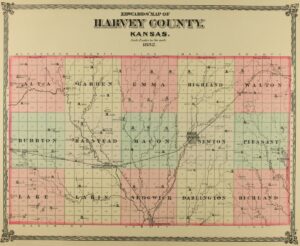Who owned the first mill in Newton? What was it called?
Elias Wood established the first steam gist mill in Newton in 1875. Newton City Mill was located on E. 3rd & Oak. In 1886, Wood sold the mill and worked as a drayman. The mill burned down in about 1903.

Elias & Nancy L Wood, children Daniel H and Nancy Ann, 1855.
Born in Ohio in 1823, Elias spent his young adulthood farming. He married Nancy A. Cutler in 1853 and they had five children. In 1872, bought a steam gist mill. In 1875 he loaded the mill up on 13 railcars and moved the mill from Peoria, Ill to Newton Ks. He rebuilt the mill exactly the same at E 3rd and Oak.
Description of the Newton City Mill.

Newton Kansan, 6 January 1876.
Sources:
- Newton Evening Republican; 6 January 1876, 28 May 1908
- Harvey County Semi-Centennial 1871-1921 Card File, Harvey County Historical Museum & Archives, Newton, Ks.





